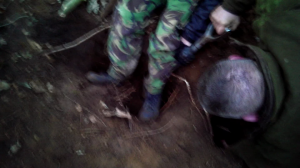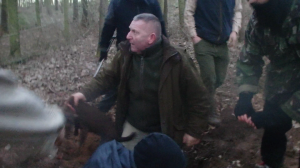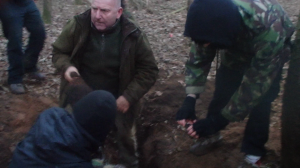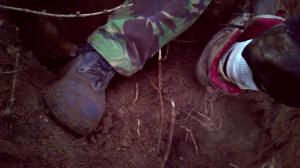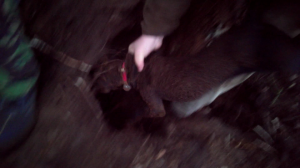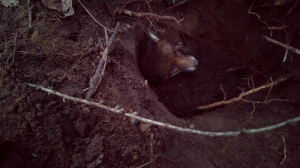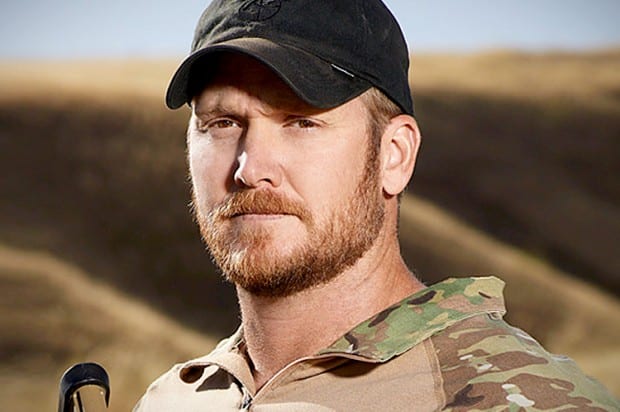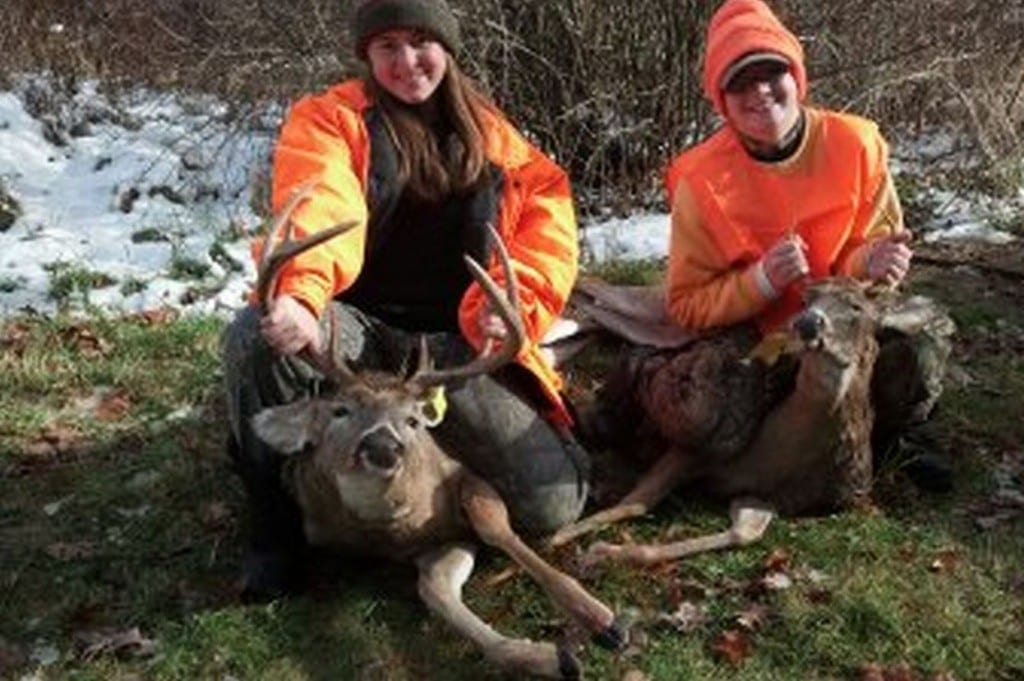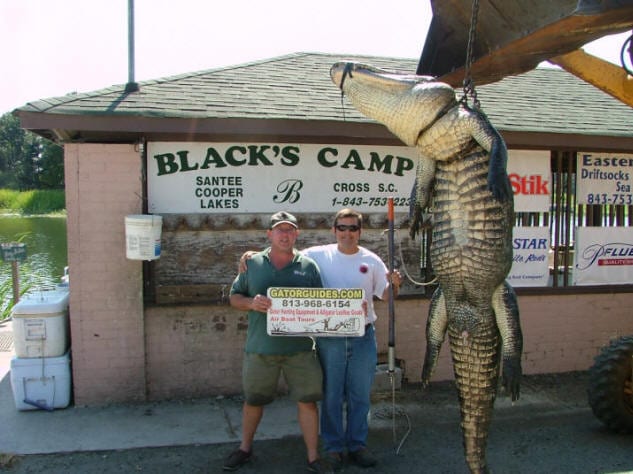
The idea for this “sport” is to locate an animal who’s minding his own business, disturb him, and kill him, so that you can get bragging rights and thump your chest as a big man.
BY MERRITT CLIFTON, Animal People
People are understandably afraid of alligators, because we are in fact on the alligator menu, along with our pets, horses, livestock, and favorite wildlife.
And, indeed, alligators are expanding their population and range. The normal range of wild alligators is already several hundred miles farther north than it ever extended before since European settlement, and as global warming continues, it is possible that alligators might even re-colonize Chesapeake Bay, which last was alligator habitat when dinosaurs were macking through Washington D.C.
But hunting alligators, as in hunting any species, is unlikely to have any longterm net effect on population range, density, or distribution. If the habitat supports one alligator, it will support another when the first alligator is killed, and if the alligator who is killed happens to be among the largest, oldest, that alligator will soon be replaced with the equivalent biomass in young alligators. They will compete for the habitat for a while, then disperse to find new habitat, perhaps becoming dangerous and problematic in an entirely new location.
If this sounds like what happened with deer, coyotes, nonmigratory Canada geese, and feral pigs, it should: it is almost exactly the same process. It is opposite to what happened earlier with beavers in the 17th into the 19th centuries, North American bison in the 19th century, and alligators in the 19th and early 20th centuries because the destruction of beavers, bison, and alligators coincided with wholesale destruction of their habitat, so that their populations could not rebound to replenish their numbers.
Said to have been trapped out, beavers were more precisely drained and dammed out; bison were plowed and fenced out; alligators were also drained out.
What this means is that there really is no public safety or conservation rationale for recreationally hunting alligators. If we truly want to reduce or restrict their numbers, we know very well how to do it. But if the object is to sell hunting licenses, wildlife agencies also know very well how to make “nuisance” animals proliferate to the point that the public accepts sport hunting.
Meanwhile, also of note is that alligators are able to proliferate and expand their range in part because of the increasing abundance of swamp-dwelling feral pigs. These are mostly the descendants of pigs lost in trucking accidents, between factory farms and slaughter. Trace the spread of feral pigs on a map and the spread of alligators follows it wherever the habitat accommodates alligators (pigs don’t need as much water, so have moved on farther north.)
Of course state wildlife agencies are now also encouraging pig hunting — in the name of extirpating an “invasive” threat. But no one has ever succeeded in extirpating feral pigs from mainland habitat, and killing the big boars, who are incidentally cannibalistic and the major predators of piglets, just accelerates pig feral proliferation.
We also have the technology to stop feral pig proliferation. The use of porcine zona pellucida in animal birth control formulations has been known for more than a decade. USDA Wildlife Services is actually manufacturing drugs based on porcine zona pellucid for birth control use in other species. But we are not seeing serious efforts made to chemically control feral pig populations because pigs, like alligators, offer hope to wildlife agencies funded by hunting license fees that sport hunting can be revived, despite a 30-year decline in participation, and can again fund those agencies’ existence.
Come we now to pythons, ostensibly the greatest threat to Floridans’ health and well-being since the Cuba missile crisis.
In all the 35 years I have been tracking animal attacks, never once have I encountered a case of a wild python killing or injuring anyone — but starving escaped captive pythons kill children every couple of years, including two children just this year.
The relationship between the abnormal conditions of captivity and risk to humans is important to understand: attacks occur because the pythons are in situations where they simply do not belong. Pythons in captivity are often very dangerous; pythons in the wild rarely take any interest in humans.
Of note, I had already recorded several fatal attacks by escaped captive pythons when in 1997 I first saw washerwomen in India set up under a tree with a big python in it, with their children playing nearby. Thinking I was about to see a catastrophe, I shouted a warning & they thought I was crazy.
They knew all about the python, I learned — that’s why they chose that tree. The python had lived there for years. Because the python was there, the washerwomen knew that they and their children would be safe from leopards, who would not be in the same tree as a python, and from crocodiles.
Pythons evolved, long before mammals existed, as predators of crocodilians. The constricting method of killing used by pythons and anacondas takes advantage of the “death roll” used by crocodilians to drown prey and fend off attackers.
Mammals & birds are secondary prey for pythons, who may grab what’s easy, but mostly don’t bother with warm-blooded species, especially if those species are large or quick.
Some deer & pigs are eaten by feral pythons in Florida, but alligators are their primary prey. The proper habitat for a python is habitat that supports their prey.
The expansion of alligator range, and their increasing numbers, ensures that pythons can extend their range too, and can become yet another “big game” species used by wildlife agencies to encourage hunting.
Human terror of snakes, especially large snakes, can be traced back far beyond Eve’s alleged misadventure to the instinctive response of practically any monkey to anything that even looks like a snake.
This raises many issues pertaining to relative risk,
including the all-important differences among absolute risk,
relative risk, actuarial risk, and perceived risk.
Absolute risk is a matter of odds.
For example, human hunters kill just under 100 humans per year in the U.S., on average, most of whom are themselves or fellow hunters.
As the hook-&-bullet crowd often remind, fewer innocent bystanders per year die as result of hunting activity than die while taking a bath, or taking a crap (the common fate of John Coltrain, Lenny Bruce, & Elvis Presley).
The odds that one will be killed by a hunter are only about two-thirds of the odds that one will be killed in a deer/car collision.
Relative risk divides risk by the opportunities for exposure. The average hunter hunts on only about 17 days per year. Very few hunters hunt for more than 100 hours per year.
Deer, by contrast, are at large 24 hours a day, so have more opportunity to kill a human in just over four days than a hunter does all year. There also are considerably more deer than there are hunters.
But, overall, walking in the woods during hunting season is astronomically more dangerous than driving in deer habitat.
The same sorts of calculation can be done, with similar outcomes, pertaining to taking a bath, or taking a crap.
Come fall, the woods are annually full of constipated unwashed hunters, whose own guns, contrary to their perception, are markedly more likely to kill them than either a bath or a meatless meal.
Actuarial risk compares the incidence of an event with the economic consequences.
To demonstrate this, consider that there are about 4.8 million dog bites per year in the U.S. that receive some sort of medical treatment. Very few of these result in insurance claims, so most are not a factor in actuarial risk.
Actuarial risk accrues from very severe dog attacks.
Since 1982, I have logged 4,392 attacks by dogs kept as pets in which someone was killed, maimed, or otherwise visibly and permanently disfigured. Of these attacks, 2,783 were by pit bulls, 536 were by Rottweilers, and a total of 3,555 were by pits, Rotts, and their close molosser kin.
In short, 80% of the actuarial risk incurred by the entire dog population of the U.S. over the past 31 years has resulted from only 4,392 incidents among more than 150 million bites, done by dogs of breeds who make up just 9% of all the pet dogs in the U.S.
Come we now to perceived risk, which is where we return to alligators and pythons.
Perception of risk, like religious faith, is mostly a matter of intuition. Calculations of absolute, relative, and actuarial risk barely even enter into it.
What does enter into it are millennia of evolution that have pre-conditioned us to respond to the same perceived threats that our rodent and lizard ancestors did, in much the same manner: by paying particular attention to anything that might resemble the threats, and by preparing for fight or flight.
Humans evolved as a prey species, so have an inordinate irrational fear of predators, relative to the risks from disease and accidents, which have become proportionately far greater now that we have made our world mostly free of predators other than human criminals, perverts, & politicians.
Two very good books have explored this in recent years.
Monster of God, by David Quammen, is actually a book mostly about faith, exploring the influence of the human evolutionary role as prey upon concepts of religion, and of the more recent human ascendance as a top predator on our ideas about conservation.
Quammen presents a strong circumstantial case that the protohuman concept of God evolved as a psychological response to swift and seemingly random predator strikes. Sacrifice, Quammen suggests, began as appeasement of predators, as in the example of feeding virgins to dragons that I often use to illustrate predator/prey population dynamics, and in some remote places continues as such.
Quammen explores the role of the earliest monarchs in recorded history as lion-slayers, pointing out that the dawn of civilization coincided with the emergence of humans as quasi-apex predators, able at last to do with weapons what natural predators do with tooth and claw.
Quammen also devotes a chapter to human fear of crocodilians, the order including alligators.
Man The Hunted, by Donna Hart & Robert W. Sussman, demonstrates how the sustained challenge of being a prey species has driven the evolution of human thought.
The experience of predation, Hart & Sussman argue, actually shaped human culture. Among the enduring consequences are societal attitudes toward meat, hunting, choices of mates and leaders, choices of pets, which animals become the icons of athletic teams, which attract donor support as subjects of appeal mailings, and even what humans most often choose to watch on television and read about on the web.
Many years ago, when there was discussion about the San Francisco Giants possibly relocating, and of an expansion team replacing the Giants, there was speculation about what such an expansion team might be called. My theory was that since a team name should somehow reflect the community, and should be something scary to others, the new San Francisco team should be called the Faggots.
Nothing would scare the average American male more. Imagine Barry Bonds, earring & all, in a pink uniform with orange flames in place of ornamental piping. Opposing pitchers would wet their pants right on the mound.
This idea of course went nowhere, and Bonds is long since retired, but some years later, after the term “sexual predator” came into vogue, the Orlando football franchise adopted the name “The Predators,” & I realized that a successful team name has to be not only threatening but
evocative of being a predator, rather than prey.
Accordingly, the St. Louis Cardinals have done very well for more than a century in a city which has historically been heavily Catholic.
Likewise the San Diego Padres of the National League, and the Pacific Coast League before that, have done well for almost a century.
Now that I have offended hunters, pit bull fans, gay people, baseball fans, football fans, Catholics, & Barry Bonds, but have kept a lot of people reading for quite a long time to see what happens next, let me note that I first explained the psychology behind all of the above more than a decade ago in a series of “Follow the monkeys!” postings about the evolution of news reporting.
The gist of “Follow the monkeys!” was that human news consumption habits evolved somewhere between bats and lemurs, about 70-80 million years ago, when it was still possible to blame everything really bad on T-rex, i.e. a higher power and irresistible force, distantly related to alligators and pythons.
T-rex was perceived as a far greater risk than a changing climate, rising seas, and the possibility of the sky falling.
Thus formed the intellectual framework that governs politics, including the politics of wildlife agencies and the psychology of defending and promoting hunting.
ABOUT THE AUTHOR
Veteran journalist Merritt Clifton serves as editor of ANIMAL PEOPLE, the world’s leading independent newspaper devoted to ecoanimal issues.
____________________________________
ANIMAL PEOPLE
P.O. Box 960
Clinton, WA 98236
Telephone: 360-579-2505
Cell: 360-969-0450
Fax: 360-579-2575
E-mail: anmlpepl@whidbey.com
Web: www.animalpeoplenews.org


